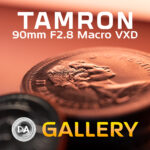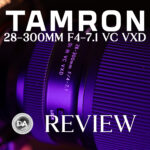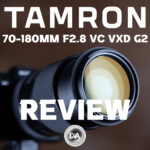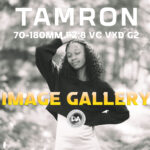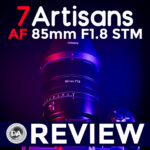
Tamron 90mm F2.8 Di III Macro VXD Review
Sony E-mount has had perhaps more lens development than any other mount in history. Want an autofocus 35mm lens? You easily have 20+ options to choose from in that focal length alone. I review nearly 100 lenses per year, and many of them are for E-mount. But I realized about two years ago how few autofocusing macro lenses I have reviewed on E-mount. The last autofocusing macro lens that I reviewed on Sony was the Sigma 105mm F2.8 DN Macro…in 2020! Before that was the Sony 90mm F2.8 G Macro lens. That means for four years we have hundreds of other lenses but no AF macro lenses. I finally asked Tamron last year when they were going to make one, as back when I was exclusively reviewing on Canon EF, Tamron was perhaps the main third party player in the macro space. My Tamron contacts didn’t have an answer for me at that point, but, about a year later, I got an email from them stating that (finally!) the Tamron 90mm F2.8 Di III VXD 1:1 Macro was on the way. It’s now here, and I think it is the macro lens a lot of people have been waiting for. It’s cheap ($699 USD), has fantastic autofocus, and is just brilliantly sharp. I want one! Find out why in my video review shared below or read on in the text review.
Follow Me @ YouTube | Patreon | Instagram | Facebook | DA Merchandise | Flickr | 500px | X
Thanks to Tamron USA for sending me a review loaner of this lens. As always, this is a completely independent review. *The tests and most of the photos that I share as a part of my review cycle have been done with the Sony a7RV along with the Sony Alpha 1 that serve as my benchmark cameras for Sony lenses.
__________________________________________________________________________________________________
I’m doing this review on Sony E-mount, as mentioned, but Tamron is also releasing (for the first time) simultaneously on Nikon Z-mount, where it will also be extremely welcome.
Here’s a look at the overall selling features of the new 90mm Macro, or what Tamron codes the F072:
- Full-Frame | f/2.8 to f/16
- Short Telephoto Prime
- VXD Autofocus System
- 1:1 Magnification
- 9.1″ Min. Focus
- Focus Limit Switch, Focus Set Button
- BBAR-G2 & Fluorine Coating
- Moisture Resistant Construction
That’s pretty standard stuff, but it is the execution here that is fantastic. This is a lens that just works, and I love the images that it produces.

And, a 90mm lens is useful for all kinds of things, including making for a fantastic portrait lens.

It also made for a gorgeous landscape lens, delivering beautiful color and contrast.

A good short telephoto macro lens is so much more than just a macro lens, and there’s a reason why I have recommended such lenses to those who were debating about a macro lens or a portrait lens; a good macro lens does all of those extremely well. Let’s dive into why that is…
Tamron 90mm Macro VXD Build and Handling
Let’s parse out the “Tamron speak” in the 90mm F2.8 Di III Macro VXD lens.
- Di III = Designed for Mirrorless
- VXD = Voice-coil eXtreme-torque Drive (the Linear autofocus motor)
- Macro = a true 1:1 macro lens
I think the Di-III designation is becoming increasingly meaningless for the simple reason that essentially all current lens design is on mirrorless, with DSLRs seeming to be done at this point.
The new Tamron 90mm Macro is a moderately sized lens that is slightly smaller and lighter than its two chief competitors – the Sony 90mm F2.8 G Macro and the Sigma 105mm F2.8 DN Macro. It measures 79.2mm (3.1″) in diameter and is 126.5mm (5″) in length. Macro lenses like this tend to be a little longer because they are internally focusing.

By comparison, the Sigma lens is 135.6mm in length (+9mm) and the Sony is 130.5mm (+4mm). The Tamron employs a 67mm front filter thread that is a match for the vast majority of its lenses over the past five years. They have very intentionally tried to standardize filter size where at all possible to allow filters to be shared across their lenses.

The weight is 630g (22.2oz), which undercuts the Sigma by 80g but is slightly heavier than the Sony (+28g).
The design language is similar to a number of recent Tamron lenses, though you can tell that this isn’t one of their premium lenses in that the materials don’t feel quite as plush. The lens shell is primarily engineered plastics with a rubberized focus ring. The lens has a satin finish with some sculpting here and there along with a raised bank for the switches and buttons.

The raised control bank has two elements: a function button whose value can be assigned either through the camera or via Tamron’s Lens Utility software (more on that in a moment). There is also a three position focus limiter, allowing you to choose the full range, eliminate the macro range (0.7m to infinity), or to select just the macro range (0.7m and closer).

Tamron’s Lens Utility software is available from the Android app store or you can visit this page to download the software and/or get more information: The lens is accessed by connecting to the weather sealed USB-C port in the side of the lens.

There are a variety of functions that can be set in the software itself, everything from a preset focus position to switching between AF/MF to even establishing a proper Astro/infinity focus point. The nice thing about being able to use the Lens Utility function to assign this value is that you can program a function specific to this particular lens rather than using the default value from the camera. This lens has no AF/MF switch, for example, and that happens to be one of the choices that I could set the button to accomplish.

Very importantly for a macro lens, you have a lot of specific control over how the manual focus ring functions. You can choose which direction it moves, whether it is linear or non-linear, how long you want the focus throw/rotation to be, etc…

You can also do direct firmware updates through the software, ensuring that your lens stays future proof. That degree of customization is great, and I would definitely call this an advantage for the Tamron lens.
The focus ring is raised from the lens barrel a bit in a section of the lens that flares out, making it more ergonomic and visually pleasing. Manual focus emulation is quite good, and the quality damping gives the impression of being a real manual focus experience. It is pretty typical to employ manual focus at macro distances, as depth of field is incredibly tiny and manual focus is really the best way to put focus where you want.

Tamron has included a fairly deep lens hood with the 90mm Macro. It is more than half the length of the lens itself.

You’ll note that Tamron has equipped the hood with a filter window, which is rare for them. The purpose of this is to allow circular polarizing filters (often used to reduce reflections in macro photography) to be easily accessed and rotated. They probably felt this to be necessary because of how deep the hood is.

Tamron has really been nailing weather sealing, and that’s definitely the case here. There’s a rubber gasket at the lens mount that suggests at the weather sealing inside, and Tamron also shows a total of 6 other internal seal points along with a fluorine coating on the front element to give further protection. A fluorine coating not only helps protect the front element from scratches but also makes it water and fingerprint resistant and thus easier to clean. This is a professional grade lens ready for professional use.

Tamron has elected to not include their VC (Vibration Compensation) in the 90mm Macro. That’s a departure from their last 90mm Macro (released in 2016). They are clearly banking on most Sony and Nikon shooters having a camera equipped with camera-based stabilization. I didn’t really have any issues with either my Sony a7RV or Alpha 1, and, if I had the Nikon version, I like the stabilization in my Z8 even better. The Sigma 105mm also doesn’t have stabilization, leaving the Sony 90G as the only option in the trio equipped with lens-based stabilization (though it also comes at a $400 premium over the Tamron).
Somewhat unusual for the 90mm Macro is that the aperture iris has 12 rounded blades. The intent here is for the lens to maintain a very circular shape when stopped down. Here’s a look at specular highlights with the lens stopped down to F5.6:

Minimum focus distance is 23cm, or 9.1″. That puts you fairly close to your subject, but not right on top of it. Maximum magnification is of course 1:1, or 1.0x.

Good macro lenses don’t just provide high magnification, but are corrected in order to give a very flat plane of focus. You can see from this shot that detail is good all across the frame.
Depth of field is incredibly small at this level of magnification. Even stopped down to F5.6 you can see that just the tips of these screws are in focus.

Using an even blade count like this will produce a 12 bladed sunstar.

All in all, this is a very nice package. I would have liked a dedicated AF/MF switch, but this is a lens that provides nice value for money at the MSRP of $699 USD.

Autofocus and Video
Tamron has the 90mm macro their premium focus system, which they callthe Voice-coil eXtreme-torque Drive (VXD). Macro lenses tend to focus slower than normal lenses of similar focal lengths due to have so many more focus possibilities in the macro range. That can be helped via using a focus limiter, but fortunately here that really isn’t necessary, as the Tamron 90mm Macro VXD lens stands out for having extremely fast autofocus for a macro lens.

I was consistently impressed by the speed and confidence of the autofocus motor. I only noticed a slowdown if I was shooting into a strongly backlit subject and with a smaller maximum aperture (pretty typical). While it is true that I will still often switch over to manual focus when shooting at macro distances, the inclusion of fast autofocus makes this a much more versatile lens for general purpose or portrait use. I was even able to snap up and catch a bird in flight.

I recognize that the image above isn’t overly inspiring, as 90mm was far from sufficient reach for that shot. But what matters is that I was able to swing up the camera in a quick reaction and immediately acquire (accurate) focus. Lenses with slower focus motors will often struggle to acquire a subject like this.
I used the lens a bit as a part of a portrait session, and saw perfect focus results with quick acquisition of the eye and accurately focused end results.


I was also able to effectively focus at close/macro distances. Using continuous AF allowed me to maneuver around to the composition I wanted and then quickly snap the shot. This is a great technique for getting handheld macro where manual focus proves much more difficult.

Focus is not only fast, but also very quiet and confident. It moved quickly and smoothly from one subject to another in my formal tests, and when testing for Eye AF, focus stayed locked solidly on the eye as I moved throughout the frame.

Video AF is likewise excellent. When I tested focus pulls, they were snappy and confident. No settling or pulsing. Focus breathing exists but not strongly.
My “hand test” where I alternately block the camera’s view with my hand and then remove the obstruction of my hand also went well. The camera moved easily from my face to my hand and vice versa.
The bottom line is that AF was pretty effortless. Tamron’s VXD is a very good focus motor, and this is one of the best focusing macro lenses that I’ve used.
Image Quality Breakdown
Tamron has been making 90mm macro lenses since 1979, so it is safe to say that they know what they’re doing at this point. The optical design is fairly complex for a prime lens with 15 elements in 12 groups, including 4 low dispersion elements. The MTF looks very good as well, with excellent center and mid-frame performance and then a natural fade into the corners.


Macro lenses tend to be very sharp lenses, and the Tamron 90mm Macro VXD is no exception. It delivers very good detail and contrast and also has excellent control of the fringing that can easily affect macro lenses.


We’ll dive into the technical side of things first with a look at vignette and distortion at 90mm F2.8:

Somewhat surprisingly, there is a bit of barrel distortion present here. Not a significant amount (+4 to manually correct on the right), but not zero. I would have expected that the distortion would be more of the pincushion variety at this focal length, too. Not a huge deal, but it will need correcting if you need perfectly straight lines. Tamron gets good profile support, fortunately. There is also a bit of vignette, though this is relatively insignificant at a +37 to correct. That’s a little over a stop, so not significant most of the time.
LoCA (Longitudinal Chromatic Aberrations) present as a color fringing before and after the plane of focus. This can really impact macro lenses because they are capable of truly tiny depth of field and are often used to shoot shiny objects, like the edge of this silver dollar.

I see very minimal fringing there, which allows contrast and detail to be all the better.
I looked for lateral chromatic aberrations (LaCA) near the edges of the frame, where it exhibits as fringing on either side of dark lines, but see absolutely nothing. This is perfectly corrected.

Other than a bit of distortion, this is a pretty flawless performance.
Here’s my test chart that the crops will be taken from. Tests are done on a 61MP Sony a7RV and crops and comparisons are shown at 200% magnification.

Here’s a look at F2.8 crops from the center, mid-frame, and bottom right corner:



That’s a very strong performance across the frame, and the corners look a bit better than I expected. That’s great detail in the corners for being examined at 200% on a 61MP camera. In real world shooting results are very crisp even at macro distances (and using F2.8).


One thing important to understand about macro lenses is that physics dictate that the effective aperture will be smaller at macro distances, so even if you’ve got the aperture opened to F2.8, it will be behave more like F5.6 at very close focus distances, which is why you need a good amount of light for macro work.
At standard distances you’ll find that you have plenty of sharpness even when shooting landscapes at F2.8:


Stopping down to F4 provides an improvement to contrast and detail, though primarily in the outer mid-frame and corners, as the center is already pretty close to perfect.

There’s a slightly more noticeable uptick at F5.6 in overall contrast that is again most noticeable in the corners due to the vignette disappearing. F8 is about the same as F5.6, which is to say excellent!
As per usual you can expect a significant dropoff in sharpness after F11 due to diffraction. Minimum aperture is F16 here, and it is considerably softer than larger apertures.

Macro images show good detail and contrast even when shooting at F2.8:


I typically like to stop down a bit more when shooting macros, as you can see here that even at F5.6 depth of field is particularly small.

Bokeh is a strength for the 90mm Macro VXD lens as well. You can see that the geometry is very good here at F2.8, with circular specular highlights across the frame.

Bokeh at slightly further distances was also nice.

Colors were also very nice, with good levels of saturation.

Colors on this blossom also looks nice.

I did get a chance to shoot the stars with the lens, and coma is extremely well controlled all across the frame.



The lens hood is really deep, so I wondered if flare resistance were perhaps a problem, but I don’t see any particular issues. There is a bit of veiling and a tiny bit of ghosting, but nothing significant.



Bottom line is that this is a really lovely optical instrument that worked well for all the different types of photography that I used it for.

I had a very positive feeling about the Tamron 90mm F2.8 Macro VXD lens. I think it will do very, very well for Tamron. Check out the image gallery link here for more photos.
Conclusion
The Tamron 90mm F2.8 Di III Macro VXD is a lens whose only surprise (to me) is that it took so long to arrive. This lens makes perfect sense, delivering faster autofocus and better image quality than any macro lens we’ve seen on Sony E mount so far. Tamron has been making macro lenses for a very long time and they are obviously very good at it. I liked pretty much everything about the 90mm Macro.

I regularly use a Laowa 90mm F2.8 Macro for my product photography on this channel, and while I like the lens, it is limited in its versatility by being manual focus only. The Tamron 90mm would be a great short telephoto lens even if didn’t have macro capabilities, but fortunately it is also an excellent macro lens.

There’s no question that it is great value at the price tag of $699 USD. There are cheaper options out there, but not that offer the combo of autofocus, optics, and build (including weather sealing) for this price. I suspect that Tamron will sell plenty of these on both Sony E-mount and Nikon Z-mount.

Pros:
- Slightly smaller and lighter than competing lenses
- Nicely built
- Useful features
- Thorough weather sealing
- Ability to customize manual focus behavior
- Extremely fast autofocus
- Good focus accuracy
- Video AF works well
- Low distortion
- Chromatic aberrations nearly perfectly controlled
- Very nice bokeh
- Excellent sharpness
- Low coma
- Great price to performance ratio
Cons:
- No AF | MF switch
- A bit of barrel distortion
_________________________________________________________________________
GEAR USED:
Purchase the Tamron 90mm F2.8 VXD Macro @ B&H Photo | Adorama | Amazon | Camera Canada | Amazon Canada | Amazon UK | Amazon Germany
___________________________________________________________________
Purchase the Sony a7RV @ B&H Photo | Adorama | Amazon | Camera Canada | Sony Canada | Amazon Canada | Amazon UK | Amazon Germany
__________________________________________________________________
Purchase the Sony a7IV @ B&H Photo | Adorama | Amazon | Camera Canada | Sony Canada | Amazon Canada | Amazon UK | Amazon Germany
_________________________________________________________________
Purchase the Sony Alpha 1 @ Camera Canada | B&H Photo | Adorama | Amazon | Sony Canada | Amazon Canada | Amazon UK | Amazon Germany | Ebay
_________________________________________________________________
Want to support this channel? Use these affiliate links to shop at: B&H Photo | Amazon | Adorama | Camera Canada | Amazon Canada | Amazon UK | Ebay | Make a donation via Paypal
Buy DA Merchandise https://bit.ly/TWIMerch

Keywords: #withmytamron, Tamron, 90mm, Tamron 90mm Review, Tamron 90mm Macro, Macro, Tamron 90mm Sony, Di III, 1:1, VXD, Travel, Tamron 28-200mm, Full Frame, Review, Sony Alpha 1, Sony a7RV, Review, Hands On, Dustin Abbott, Real World, Comparison, Sharpness, Bokeh, Flare Resistance, Autofocus, Image Quality, Sample Images, Video, Photography, let the light in, weathersealing, #letthelightin, DA

